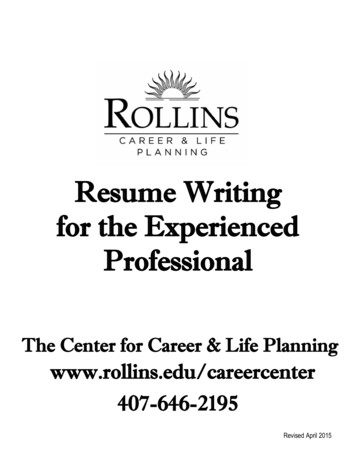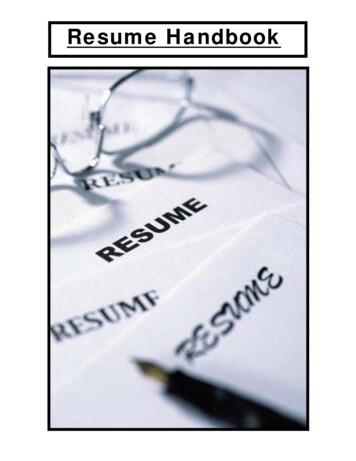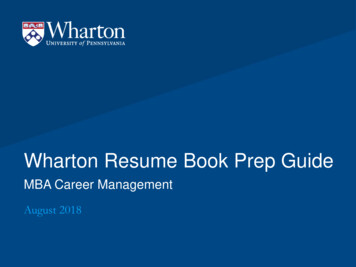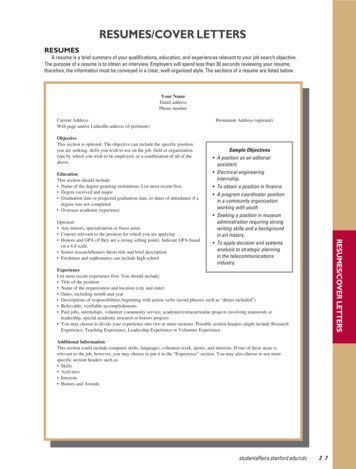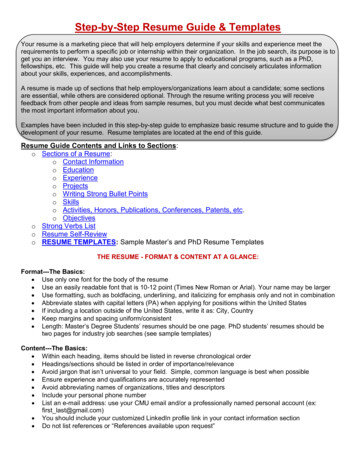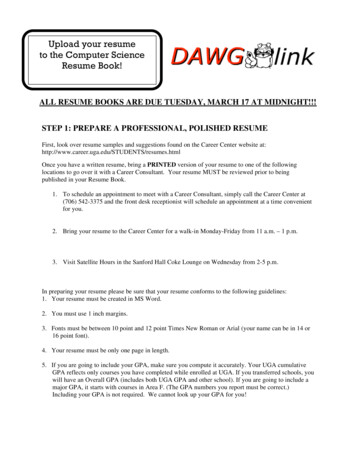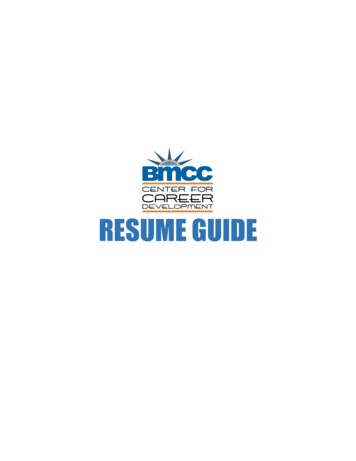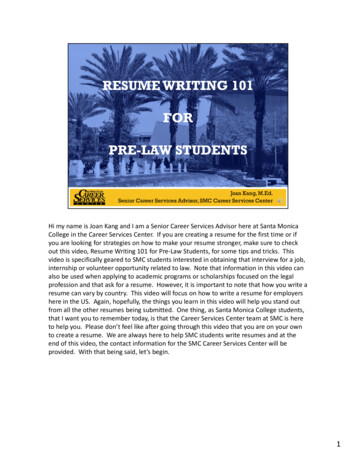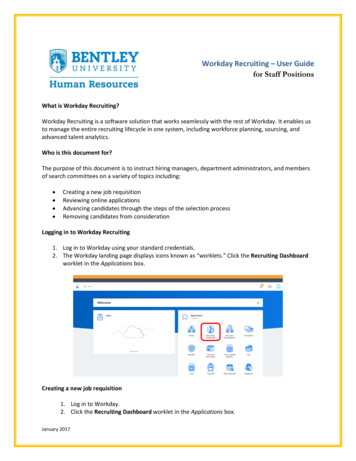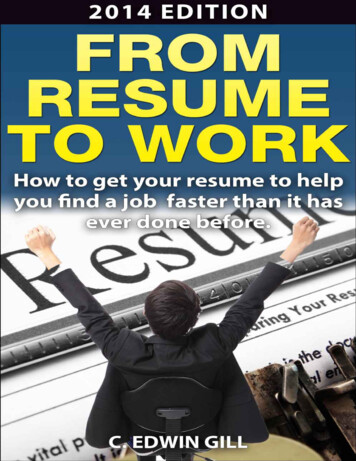
Transcription
From Resume To WorkBy C. Edwin GillPublished by GudeJob.com
From Resume to WorkCopyright 2014 by C. Edwin Gill. All rights reserved. No part of this book may be reproduced ortransmitted in any form or by any means, mechanical or electronic, including photocopying or recording, orby any information storage and retrieval system, or transmitted by email without permission in writing fromthe author or publisher. Anyone reviewing this book may quote brief passages in reviews with appropriatereferences to this book.Every attempt has been made to check and verify all information provided in the publication; however,neither the author or publisher assumes any responsibility for errors, omissions, or contrary interpretationsof the subject matter herein; nor does the author or publisher assume any responsibility or liabilitywhatsoever on the behalf of the purchaser or reader of this material.Adherence to all applicable laws and regulations, including international federal, state, and local governingprofessional licensing, business practices, advertising, and all other aspects of doing business in the UnitedStates, Canada, or any other jurisdiction, is the sole responsibility of the purchaser or reader.
Your Free GiftIn this book, From Resume to Work, I share with you the 10 challenges to watch out for on your resumeand how employers are now looking at each challenge as a potential landmine in your business characterwhich gives them another reason to pass on your resume. I then share a pet peeve of the most anal ofemployers called the dangling resume.As a way of saying thank you for your purchase I would like to offer you a free compliment to this bookcalled 5 Fixes to the Dangling Resume.5 Fixes to the Dangling Resume provides you with five ways to correct the dangling resume therebysaving you from getting passed over for that particular landmine. It is a part of my developing SolutionsSeries in which I share step-by-step solutions to a particular issue.Your free gift comes as a PDF download. It is a resource of over 25 pages that includes detailed stepsalong with screenshots of how to fix your dangling resume problem. I again want to thank you for yourpurchase. You can download this free offer by going here.
Table of ContentsIntroductionYou Have The AdvantageTaking Some First StepsWhat You Can ExpectIntroduction PointsResumes That Get Rejected1. Not Following Instructions2. Not Correcting a Challenging Resume3. Not Checking the Resume (and Cover Letter) Again4. Not Meeting Minimum Qualifications5. Not Being PresentRejected AnywayResumes That Get Rejected ChecklistYou Must Be Present1. Be Present With A Job2. Be Present With Education or Training3. Be Present With Your Own Business4. Be Present As A VolunteerYou Must Be Present ChecklistCover Every Point1. Cover Every Qualification2. Cover Every Responsibility3. Cover Every PointDon’t Get TemptedCovering Every Point ChecklistChecklists Before Getting StartedYour Checklist Before Getting StartedYour Checklist For Each Job AnnouncementYour Checklist For Staying DiligentThank You
INTRODUCTIONYou have your resume in hand and you’re looking for work, so what do youdo? Send it out to potential employers, right? True, but before you do youmay want to know that this book, From Resume to Work, has some extremelyimportant experiences to share with you to help your resume put you towork faster than it has ever done before.From Resume to Work is published by GudeJob.com, where our motto is, “Don’tjust do a job, do a GUDE job!” Our goal is show you how to get the employerto absolutely, positively, and undeniably fall in love with your resume everytime by making the right connection with him or her.After you read this book, listen to it, and then put into practice the strategieswhich are sure to move you From Resume to Work.How many resumes should you send out before you get that first response:10? 20? 100? Recent studies show that unless a person has a specialized skillfor a high-demanding job, it usually takes 25 to 50 resumes before you canexpect your first response, a two-to-four percent response rate. And by aresponse we mean that the employer loves your resume and wants toconnect with you to follow up about it.This is not unusual. In today’s economy with massive layoffs, a growingworkforce, and access through technology, employers are squeezed for timeand resources when it comes to searching for candidates. One job postingcould yield 100 responses or more, so finding the right person is often likesearching for a missing piece to a huge jigsaw puzzle. Your job (and ours) isto make it easier for the employer to select your resume above all others.
You Have The AdvantageUsing this book gives you an advantage over every other job seeker who doesnot have this resource. It was developed with the assistance and input fromhuman resource professionals, job developers, hiring managers, headhunters, employment psychologists, employment agencies, business owners,non-profit professionals, and managers in government with over 40 yearsexperience of hiring people across multiple industries. Many of theseprofessionals continue to stay on the cutting edge of hiring practices andtrends in the marketplace.In addition, portions of this material were developed for use in jobworkshops and seminars where employers were instructed on effectivemethods of hiring the right person. In short, you have a powerful tool thatwhen used correctly will yield a definite increase in your resume responserate.
Taking Some First StepsThe first step in preparing to use this material is to make sure that you haveyour resume and cover letter up to date. Produce what you will use as yourfinished product and make sure that you are satisfied that it is polished andready to send out. It is always best to have another set of eyes look at yourresume. Even if writing resumes is your thing, it is important to get as muchconstructive feedback as possible.Once your resume and cover letter are completed and ready to go, writeTEMPLATE on them. That’s right. What you thought was your final,finished product serves only as your template for the purposes of this book.Remember that no resume is ever static if you want to increase your resumeresponse rate and make the transition from resume to work. Therefore, yoursecond step is to let go of the notion that a single version of your resume willwork for any and every job posting.The third step in using this material is that you must prepare yourself to slowdown your resume campaign. This may mean applying for fewer positionsthan you have in the past. This notion is contrary to the job hunting methodthat too many job seekers are relying on today: the blasting method.The blasting method is where you send out a standard resume and coverletter to practically any and every job posting that even faintly resembleswhat you might want to do for a job. This method has increased over theyears as more people enter or re-enter the workforce, and continues to beused more often as the time it takes to find a job increases from weeks tomonths to years.Employers now are getting more savvy to blasters and will pass over theirresume for one that employs the strategies outlined in From Resume to Workbecause blasters are now being seen as desperate, inconsiderate, lacking
attention to detail, and impersonal, among other things. Remember thatemployers are looking to make a connection with their next employee whensifting through resumes. Another downside to blasting is that you mayeventually get a response to your resume for a job you have to settle forrather than the job that you really want.So when going through this material understand that your finished resume isjust the starting point, that no single resume will work for any and every job,and that blasting your standard resume and cover letter is not the cure-all tofinding the job you really want.
What You Can ExpectAs you implement the techniques outlined throughout this book you will notonly understand why your resume had such a low response rate, but you willalso begin to experience an increase in employers desiring to connect withyou because of how you are now connecting with them. The strategies inFrom Resume to Work have made a success story out of many job-seekers, andthe same can be done for you too.From Resume to Work covers the three essential areas needed to increase yourresume response rate: understanding why resumes get rejected, knowinghow to answer the employer’s questions before they ask, and finding the bestways to connect with the employer.Why DO resumes get rejected? First of all, you may think you know whyyour resume is not connecting with the employer, but there is a growingtrend among employers and employment agencies that have been fueled bypsychologists in the employment industry. This trend offers someexplanation as to why more and more resumes are being rejected.If you do a Google search on human resources and psychology you will findlinks that show how psychologists are now more involved in employeescreening. From Resume to Work helps you to avoid the pitfalls that theseemployment psychologists have created for the applicant.Second, From Resume to Work helps you to answer one of the top questions onthe employer’s mind before they ask it: What are you doing now? This is keybecause an employer would prefer to not make the effort to contact you andask what you are currently doing and instead go on to someone who hasalready answered that question for them. This material shows you ways you
can always answer this question regardless of your present situation.Third, this guide explains the number one principle you need to get yourresume responded to that over 95% of job seekers are not using today. This isthe principle of connecting with the employer. Most people think that unlessyou know the employer or are referred to them by a friend, you really don’thave a chance to make a connection with them. This is not true! From Resumeto Work will show you the motivation behind the job posting and lead youthrough strategies you need to make that connection with the employer.After covering the three essential areas to increase your resume responserate, you are provided with checklists that you can print out and use beforeapplying for each job. It is our goal for you to begin to see job postings fromthe perspective of the employer and know how to respond to them so thatthey will respond to you. In other words, move you From Resume to Work.
Introduction PointsPoint 1: Unless you have specialized skills for a specialized job, don’t be surprised if youhave about a two-to-four percent response rate from your resume submissions.Point 2: This book walks you through the process of making it easier for the employer torespond to your resume.Point 3: Your finished resume and cover letter are just the starting point for the purposesof this book.Point 4: Do not expect a single resume to work for any and every job.Point 5: Relying on the blasting method is not the cure-all to finding the job you reallywant.Point 6: This book helps you in three areas: identifying why resumes get rejected,answering the employer’s question about what you are doing now, and showing you howto connect with the employer.Point 7: When you implement From Resume to Work strategies, expect to increase yourresume response rate.
RESUMES THAT GET REJECTEDAfter you have worked hard to develop a perfect resume you send it out anddon’t hear anything back. Why is that? Has your resume been received?Was it lost in cyberspace? Was the recipient on vacation? Probably not. Nothearing back from a resume submission is usually a clear sign that it wasrejected.No one likes rejection, especially when it comes to their resume, the essenceof their entire educational and working life boiled down to one piece ofpaper. So why was your resume rejected? Resumes are rejected for a varietyof reasons, but primarily fall into one or more of the five rejection categorieswhich can be called The Five Not’s:One: Not Following InstructionsTwo: Not Correcting a Challenging ResumeThree: Not Checking the Resume (and Cover Letter) AgainFour: Not Meeting Minimum QualificationsFive: Not Being Present
1. Not Following InstructionsA large number of job-seekers are unaware that there is a growing trendamong employers to “test” applicants before they even submit their resume.This trend has been fueled by employment psychologists who are helpingemployers find the right candidate as efficiently as possible.Employers are being trained to give a few simple instructions in their jobpostings to candidates, usually in the “How To Apply” section of theposting. If the candidate follows the instructions exactly as it is outlined inthe “How To Apply” section, it has a tendency to mean that the applicantpays attention to detail, has a higher level of perception, and knows how tofollow instructions. If a candidate does not follow the instructions,employment psychologists urge the employer to reject the resume no matterhow good it looks because this candidate might be dull, dimwitted, or evenarrogant. At the very least the candidate does not follow instructions welland does not pay attention to detail.For example, the illustration below is an actual job posting for a FacilitiesManager for a Lutheran Church. In the second section the applicant is givenspecific instructions to email their one page cover letter and resume, sendtwo professional references, and make sure that the job title, “FacilitiesManager,” is in the subject line.
In the past, employers would still review resumes that did not necessarilyfollow each instruction; however, employers today are encouraged to rejectresumes of candidates who do not dot their i's and cross their t’s.Question: Would you try to contact the employer above by phone if you sawtheir number in the job ad? Answer: Absolutely not. In the “To Apply” sectionthe employer specifically asks not to contact them by phone. Some employersgive similar instructions and do, perhaps inadvertently, list their phonenumber. If a job applicant calls anyway employment psychologists haveurged employers to put them on the “Do Not Hire” list. (Even so, there hasbeen at least one case where the employer did ask candidates not to call butdid place their phone number in the job posting. It was a sales job, and thecandidate who called anyway got the job for being persistent. But this is theexception rather than the norm.)So you the applicant must now pay special attention to any job posting thatrequests you to do specific tasks. It is, more than likely, a test to screen outapplicants.
2. Not Correcting a Challenging ResumeWhen an employer receives your resume the first thing they look for iswhether or not the resume is challenging; i.e., is it aesthetically pleasing totheir eyes? Is the font large enough? Is the font too large? Is it crooked? Isthere something missing? Can I see everything on one, or at most, two pages?Is it inviting? If the resume is challenging, if their first impression is thatsomething is wrong, then there is a very high probability that it will berejected on the first or second pass.Employment psychologists have earned their keep by giving employers apsychology behind challenging resumes and point out that each challengemay mask a trait about the applicant that the employer should seriouslyconsider when selecting a candidate.An example of a challenging resume is illustrated below. On this resume areten of the most common challenges that these employment psychologists areinstructing employers to watch out for. If your resume is guilty of any ofthese challenges it could be the reason why the employer hasn’t connectedwith you as a serious candidate for employment:
1) The name does not stand out. If your name is small and unassuming anemployer might not remember your name or your resume. Psychologists tellemployers that unassuming candidates may have low self-esteem issues ormay be trying to hide something about a negative personality trait. Be sureto make your name stand out at least a little by making the font size largerthan the rest of the text or changing the font style.2) Minimal or unidentified phone contact. In this case there is only one phonenumber with no reference to it. Employers are told that the more contactinformation the applicant provides the more stable the candidate tends to be.If your only phone contact is not labeled the employer may hesitatecontacting you (at least by phone) because they do not have a clue how thenumber connects to you. You should list your cell phone number, a homephone number, and (believe it or not) a personal fax number, if possible. Andalways identify the numbers that you provide.
3) Use of a crazy email address. Your email address says a lot about you toan employer. Employment psychologists warn employers that candidates thatuse an email address with a handle like stupidme23 or dawg4life or anythingalluding to profanity is an indication of how the candidate could tarnish thereputation of the employer and the company. Get another email address. Themost powerful type of email address is one with your full name on it suchas billsmith@mymail.com.4) Non-uniform paragraphs. Paragraphs that are supposed to run through theend of the page and don’t leave an emptiness in the minds of employers thatsomething is missing. Psychologists tell employers not to ignore this feelingand to pass on the resume. Make sure that your paragraphs fill up the sectionappropriately. In Microsoft Word one method is to use the Show/Hide (¶)button to make sure that you did not accidently split a paragraph.5) Missing Bullet Points. Leaving a bullet point missing can send a signal tothe employer that your technical skills may be lacking. Employers areinstructed to look for inconsistencies in a person’s resume where theirSkills section says they are proficient in Microsoft Word but leave outsomething as small as a bullet point in a paragraph. Psychologists say thatinconsistencies such as these may reveal that the candidate is careless withthe truth or just plain careless. Take a moment to highlight the section whereyou want the bullet points and turn the Bullets tool on so that eachparagraph is bulleted.6) Use of extra space. Using extra space purposely or accidently causes theemployer to think that you are trying to pad your resume to make yourselflook like you have more to offer than you really do. Psychologists tellemployers to give resumes with extra spacing more scrutiny, especially whendoing employment and educational background checks. Spacing should beconsistent and the maximum spacing between paragraphs should be a singleline space.
7) Inconsistent indentation. When the alignments of your paragraph are notconsistent the employer now wonders if inconsistencies on your resume are areflection of an underlying inconsistent work pattern. Employers whoespecially need someone to write reports are warned by employmentpsychologists to look out for these types of inconsistencies on a resume.Make sure that if you indent one paragraph you indent them all.8) Inconsistent Font usage. This sends a signal to the employer that youmight not have worked on your resume yourself. Even though this is ok ingeneral, you have the overall responsibility for your resume being perfect andsubmitting a resume with varying font usage fuels the psychologist’ssuggestion to the employer that you might be someone who allows stuff tofall through the cracks. To make sure that you don’t receive this label youcould highlight your entire resume (Ctrl A) and choose one font. If you use asecond font on your resume be sure that you use it consistently throughoutyour resume (i.e., your titles or subcategories).9) The Lonely Bullet Point. Employers agree with employment psychologiststhat this is just plain laziness. Why would a bullet point ever want to be allalone on your resume? Either delete the blank bullet point or add inappropriate text for it, but never leave it alone on your resume.10) A short resume. Employment psychologists tell employers that if acandidate cannot say enough about himself or herself to fill up at least onepage of their resume then they have lived a shallow life, have very little realbusiness experience, or may be running from the law. Always make sure thatyou say enough about yourself to fill up at least an entire page. There are anumber of places to go if you need resume assistance. You can search Googlefor Free Resume Writing Help, contact a career counseling center at a localcollege or university, or look for a job placement center at your church orother non-profit organization to help you include pertinent experiences,training, and skills on your resume to fill up an entire page.Another resume issue which is not necessarily considered a “challenge” byemployment psychologists, but rather a pet peeve for the more analemployers among us, is the dangling resume (see below).
The dangling resume is a resume which has just a few extra lines of theresume all by themselves on another page. While most employers don’t mindhaving to deal with the few lines of text on another page, a growing numberof employers are finding the dangling resume annoying. You shouldtherefore make it a point to do all that you can to eliminate those extradangling lines on that last page. (To get the free book, 5 Fixes to the DanglingResume, go here.)Although you may argue that how employment psychologists interpretchallenging resumes does not reflect your character at all, the problem is thatonce the employer takes note of the psychology associated with resumes itbecomes almost impossible for them not to associate your challenging resumewith a particular character trait. Unfortunately, your resume would then berejected. However, employing the techniques in From Resume to Work helpsyou eliminate the challenging resume.
3. Not Checking the Resume (and Cover Letter) AgainCheck your resume and cover letter for spelling and grammatical errors.After you finish checking it, check it again. At minimum you should giveyour resume and cover letter a third pass before sending it out. Be sure to setyour resume and cover letter aside for a day or so before the final pass.Employers are offended when they receive a resume and cover letter withspelling or grammatical errors. If a person presents themselves in a carelessmanner they could represent the company in the same way.If after you have completed your resume using Microsoft Word you see littlesquiggly red or squiggly green lines under words (see the illustration below),that is an indication that you might have spelling or grammatical errors inyour resume.Resumes containing blatant errors are almost certainly rejected. Don't justrely on spell check but enlist the help of a friend who knows how toproofread documents. Email your resume to them not only for them toproofread but also so they can see if it prints out as you intended.Unless you are instructed to send your resume in a certain format, it may be agood idea to create a copy of your resume in PDF format so you know how itwill look once the employer receives it and prints it out.Another reason to check your resume and cover letter again has to do withidentifying inconsistencies between the two. While most people check theirresumes and cover letters for spelling and grammatical errors, too manyforget to check for consistency between their resume and cover letter.For example, if your cover letter states that you have three years experienceas an Administrative Assistant but your resume shows that you only haveone, that is an inconsistency that will most likely get your resume booted
from the selection process.Therefore, always do a “fact check” between your resume and cover letter.Fact-checking also applies to email responses and your resume. Be sure thatwhatever you say to an employer via email is consistent with what is statedon your resume because employers often attach email correspondence toresumes.
4. Not Meeting Minimum QualificationsWhen an employer states Minimum Qualifications on a job announcementthey are sending out a signal that probably indicates a number of issues: 1)they have been burned in the past by an employee who did not have theskills necessary to meet the job requirements; 2) they do not have the time towaste on candidates who do not meet certain qualifications; and, 3) therehave been legal issues surrounding past hiring practices and the companydoes not want to run the risk of being sued.Whatever the case, the company is letting applicants know that they onlywant those who meet their requirements to apply. If you know that you donot meet the minimum qualifications don't waste your time applying for theposition and move on to a position where you do meet the minimumqualifications. This is also true if you have to stretch your qualifications toomuch to fit into the job. If you are unsure whether or not you meet theminimum qualifications your time would be better spent applying for a jobwhere you are absolutely sure that you meet all the minimum qualifications.However, if you have cross-over skills like knowing Word for the PC for a jobrequiring Word on a Mac, then go ahead and apply.To make this point, let’s say that a company is hiring for an AdministrativeAssistant for an accounting firm and you have a Ph.D. in microbiology andhave worked as a Research Assistant for a university. Should you applyanyway? With the glut of applicants in the job market, employers today arelooking for candidates with more relevant work experience. Your first orderof business would be to limit your job search to those positions that directlyrelate to your formal training or work history.
Secondly, if you do apply for positions where you might have to stretch yourqualifications a bit, help the employer by explaining to him or her how yourskills are transferable to the duties they need you to perform. The more youhave to stretch yourself for the position you are applying for the more workyou have to do to sell the employer on how relevant your qualifications arefor the position. In this example the Ph.D. could spend a lot of time trying toconvince the accounting company that they should hire him as anAdministrative Assistant, or he could better use the time to look for otherResearch Assistant positions.In times past applicants use to send in their resumes assuming that if they didnot meet the minimum qualifications their resume could be forwarded tosomeone else who might need their skills. Today, this is not as effective asbefore because employers are under a lot of pressure to fill a need quickly.So do a checklist first of the minimum qualifications to see if there is a match.The more matches you find where you meet all the minimum qualifications,the more opportunities you will have to move From Resume to Work.
5. Not Being PresentEmployers always want to know what you are doing right now. If yourresume does not have a “Present” date on it, the employer is left with theirown assumptions about you, and compared to the resume that explains whatthe applicant is doing currently, the “un-Present” resume is usually passedover.Having “Present” on your resume is like having an unspoken job reference.Sad, but true, the employer's mantra is, "If no one else wants you, why shouldI want you, too?" If a resume shows that someone has been out of work for anextended period of time and is not currently doing anything relevant tofurther their career, this sends up a red flag. In the employer’s mind they arethinking, "If you are so good, then why don't you already have a job?" Theywant to know what the problem really is—perhaps you are flaky or stressedor lazy or unreliable, they may think. In any case, there is more of an uphillbattle for connecting with the employer if the resume does not explain whatthe person is presently doing.It becomes extremely important to send a signal to the employer that you area desirable candidate currently active in the job market. In our next section,You Must Be Present, you are given four strategies on how to update yourresume so that you can use the word Present. Remember, this simple wordsends a signal to the employer that you are an active participant in the jobmarket.
Rejected AnywayAs stated before, no one likes rejection, especially when it comes to theirresume. Unfortunately, even if you avoid all of the pitfalls stated in thissection your resume may be rejected anyway. Why? Because there may beother reasons which may not be easily identifiable and that you can do littleor nothing about. These include:a) The employer has already pre-selected a candidate and is going through the job search motion tosatisfy human resources or other legal requirements.b) The employer has a personal bias against your name, address, school, reference, past employer, etc.c) The employer already knows you and does not plan to hire you for whatever reason.d) The employer plans to keep the position vacant but still has to go throughthe job search process.In cases like these it is best not to try to second guess the employer but simplymove on and apply for the next job position remembering the techniques youhave learned in this book, From Resume to Work.
Resumes That Get Rejected ChecklistPoint 1: Always follow the instructions given on a job posting, especially in the How To Apply section.Point 2: Look for challenges in your own resume and enlist the help of others to eliminate these challenges.Point 3: Don’t assume that your resume is perfect. Get another set of eyes to help you from being careless on it.Point 4: Make it a habit of applying to jobs where you know you meet the minimum qualifications. Avoid thosepositions where you have to stretch your experience to meet minimum qualifications.Point 5: Always show on your resume what you a
As a way of saying thank you for your purchase I would like to offer you a free compliment to this book called 5 Fixes to the Dangling Resume. 5 Fixes to the Dangling Resume provides you with five ways to correct the dangling resume thereby saving you from getting passed over for that par


